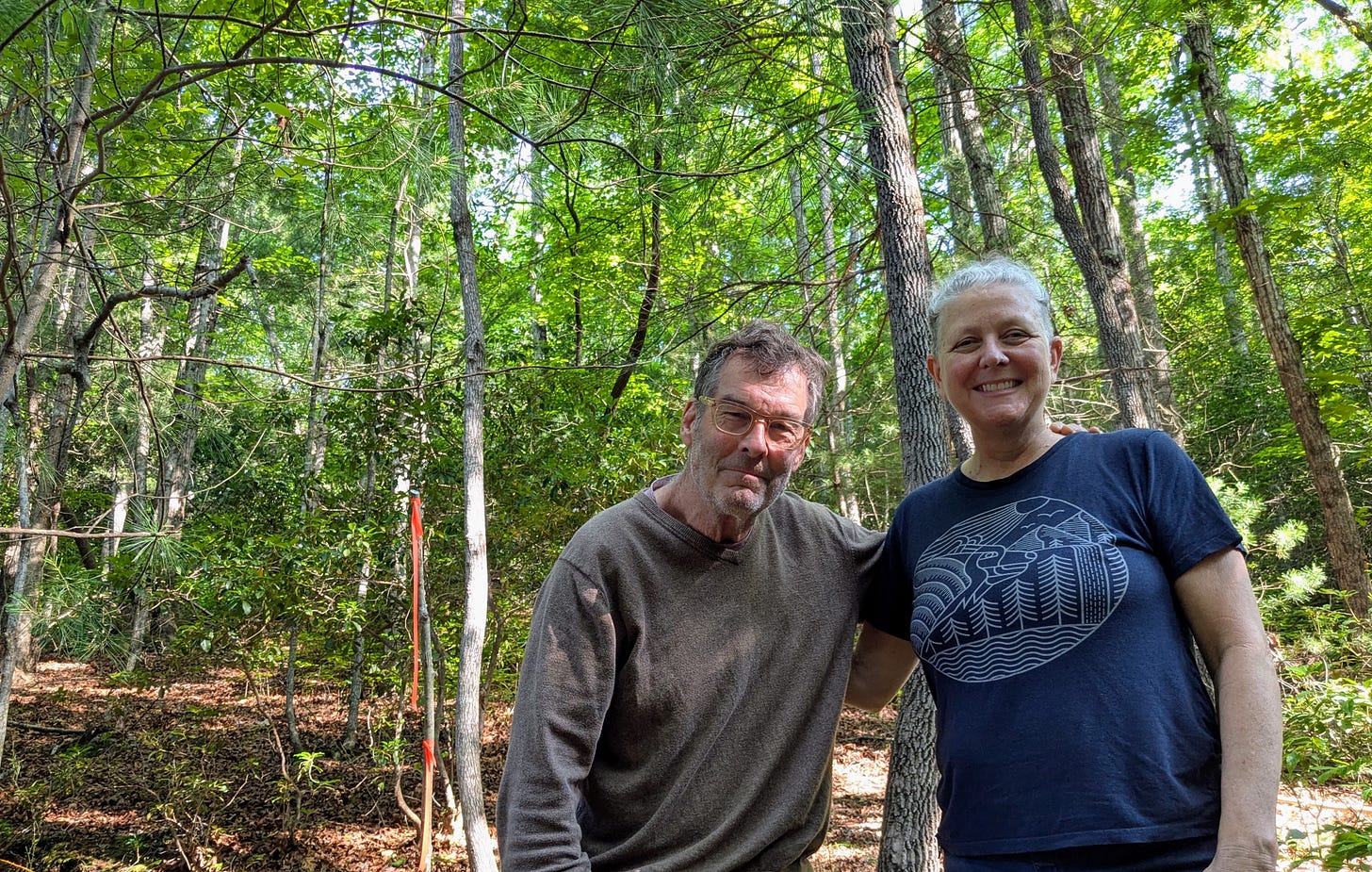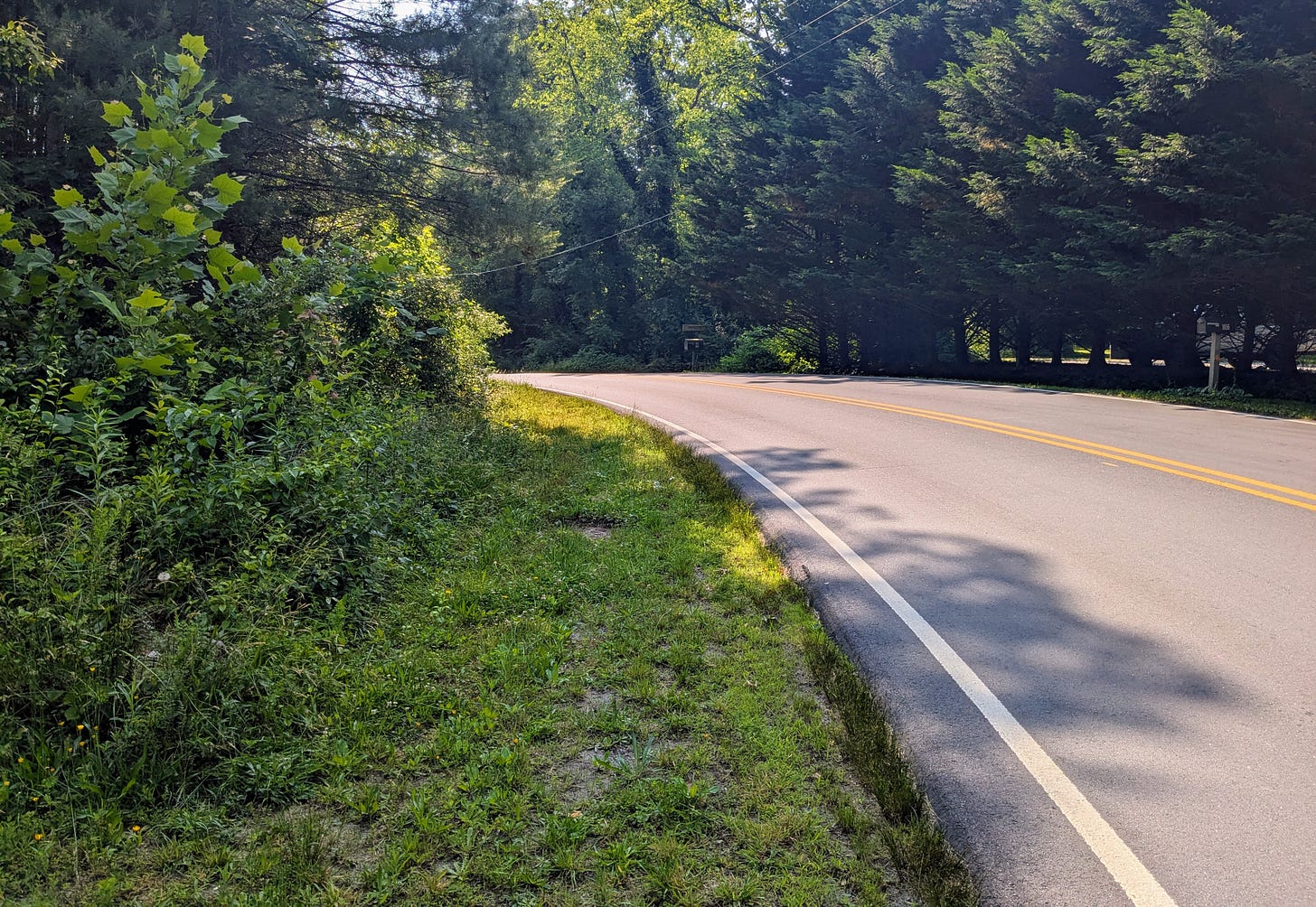More Housing on Steep Slopes: City Wants It, Neighbors Don’t
Changes to Brevard’s law on developing steep hillsides will allow both an affordable project and greater density in the biggest residential developments planned in the city in recent years.

BREVARD — Laura Rain Tree and Ron Young climbed a steep, wooded hillside bordering the site of a proposed housing development to reach a ravine with even steeper walls.
“Look how it falls off over there,” said Young, pointing to an especially precipitous slope. “It’s just crazy.”
He and Rain Tree are part of a group of neighbors fighting Burl Haven LLC’s plans for the property, which is to build Brevard’s largest residential development in at least several years — a total of 65 townhouses, small cottages and single-family homes on 11.4 acres off Probart Street near the Brevard Music Center.
On a flyer and in frequent appearances at Brevard City Council meetings arguing for reducing the development’s density, the neighbors have listed concerns common in such debates — destruction of habitat and increases in traffic as well as, potentially, stormwater runoff.
But they also say that the planned concentration of units is inappropriate on land with dizzying inclines that will require extensive clearing and grading.
Actually, opening such hillsides up for development is just what the city wants and was one of main reasons the Council voted to change its steep slope ordinance in 2023.
It is now seeing the results.
A Henderson County-based housing nonprofit is moving ahead with a proposal to build 14 or more affordable residential units on land where an earlier plan was stymied by the old rules.
And though it’s not clear exactly how much of Burl Haven’s property would have been protected by the old steep slope law — partly because of its imprecise language — certainly some of it would have been, said Paul Ray, Brevard’s planning director.
The parcel includes several inclines steeper than 25 percent and some greater than 35 percent. Under the old law “anywhere on that parcel, if it was over a 25-percent slope, would have been off limits,” Ray said.
As it stands now, because the property’s overall slope is slightly less than 25 percent, the new ordinance doesn’t apply at all, he said.
And because the land is zoned for up to eight residential units per acre, Ray added, Burl Haven has the right to build its planned mix of housing, which will help ease crushing demand that has pushed local home prices to the highest level in the region.
“What’s the number-one topic you hear at every single (City Council) meeting?” Ray asked rhetorically.
“Housing,” he said. “Anything that we can do to increase the stock, the better off people will be and the better the chances are that they will be able to buy something.”
Easing the Crunch
Buying a unit in the Burl Haven development, which has yet to be named, won’t be possible for low-income residents or even most ordinary workers, Rain Tree said.
But the development’s 18 townhouses, especially, will be as inexpensive as possible in the face of soaring construction costs, said Wes Hogan, a local architect and one of the managers of the LLC, which also includes partners based near Jacksonville, FL.
“The townhomes are meant to be our starting-at marketing point,” he said. “They’re going to be as affordable as we can make them.”
He can’t predict an exact price, he said, but the goal is to offer these units for close to the current median price of a single family home in Transylvania County — nearly $500,000, according to a recent presentation by a county property appraiser.
Yes, Burl Haven’s plans call for nine large single-family homes that will likely cost more than $1 million, he said, but these will be at the top end of a broad range of options, including eight duplex units and 14 small “cottages/cabins.”
“We haven't fully designed them yet, but they're going to be 400 to 500 square feet per level, and they're probably going to be two to two-and-a-half levels, so fairly compact,” Hogan said of the cottages, adding they will come with more high-end features than the townhouses to appeal to buyers “coming from a condo, or they’re just downsizing, and they want a place in Brevard that's simple and really well appointed.”
No matter the ultimate cost of the project’s units, he and Ray said, they should help ease demand.
Home prices have been driven up by both the desirability of the region and the acute shortage of developable land in a city hemmed in by preserved public holdings and the flood-prone French Broad River.
Burl Haven is not considered dense development by planners, Ray said, but its mix of dwellings does represent a break from the city’s dominant, land-consuming pattern — neighborhoods made up entirely of single-family homes on individual lots.
And it can be built responsibly, he said, by ensuring it adheres to the city’s Unified Development Ordinance (UDO).
Burl Haven’s parcel contains no outstanding geological features that warrant preservation under a steep slope ordinance, Ray said.
The developers will be required to submit an environmental study documenting plant and animal life on the land and meet UDO requirements that address habitat disturbance.
Burl Haven’s plans include subterranean stormwater storage tanks and other infrastructure to contain runoff, and the project will have to comply with a baseline standard of the UDO: developments can release no more water onto surrounding properties than the land did before construction.
Because Probart is a state road, the project’s single planned entrance — on a curve with limited visibility — will need a driveway permit from the North Carolina Department of Transportation, an agency spokesman said, and Burl Haven hasn’t yet applied.
Hogan said he didn’t know how previous steep-slope restrictions would have impacted development, only that addressing these inclines with the current formula was one of several regulatory hurdles faced by the LLC, which bought the parcel for $800,000 in 2023.
He is sure, however, that surmounting such obstacles and building the project will contribute to an easing of housing costs in the city and pointed to extensive research supporting this view.
“Our goal is to essentially get as many houses to market as quickly as we can,” he said, “so that those 40- and 50-year-old homes down the street from our development aren't selling for $500,000 . . . Maybe those will come back to $300,000 and then a young family that’s buying their first home can actually afford to live there.”
Affordable
Rain Tree, who built her home 23 years ago, has an alternate take on the market impact of the development.
It will likely attract wealthy out-of-towners creating more demand for public employees and service workers and, in turn, more intense competition for housing in their price range.
“Do we really have housing needs for million-dollar homes?” she asked.
But city officials have said the revised steep slope ordinance will also help its efforts to expand the availability of affordable and workforce housing.
The city’s recent moves in this realm include filling a financing gap for a federally subsidized affordable housing project planned for Asheville Highway near the entrance to Pisgah National Forest.
It will offer the land — as well as a conceptual plan drawn up by a state agency — for an affordable 48-unit development on Azalea Avenue off Old Hendersonville Highway.
Then there’s the project that directly benefits from changes to the slope ordinance. At its May 19 meeting, the Council agreed to provide Housing Assistance Corporation (HAC) with a 7.1 acre, city-owned parcel off Cashiers Valley Road.
The group, which helps house low- and moderate-income residents in Polk, Henderson and Transylvania counties, had previously looked at the land, and in 2021 submitted plans to build six homes there on lots along Cashiers Valley totaling 2.5 acres.
Then and now the idea was to make homes available to residents earning less than 80 percent of the local median income through a combination of the buyer’s “sweat equity” and low-interest federal loans.
But those earlier plans fell through, at least in part, because the city “used an outdated methodology of calculating steep slope protection areas which had unintended consequences for developing this parcel,” according to a document in the Council’s agenda packet for the May meeting.
Though the projects are different and so are impacts of city ordinances, the changes to the steep slope ordinance “absolutely” helped clear the way for HAC to move forward with its current plan to build at least 14 units on the parcel, said Meg Lebeck, the group’s executive director.
And at the May meeting, Council member Aaron Baker cited the slope amendment as one of several steps the city has made to ease the market crunch and “open up some additional land for housing.”
The Ecosystem
Still, Young and Rain Tree said, Burl Haven’s plans raise questions about whether the property off Probart is suitable for its planned density.
A view of the parcel on the county’s mapping website site makes it appear ripe for development. It is flanked on one side by public housing and separated from the city’s Bracken Preserve by both Probart and a line of existing homes.
But it’s also near several large, mostly undeveloped properties and covered by dense green forest. During the Tuesday tour along the property’s boundary, the only audible sounds were the passage of an occasional car on Probart and the constant calls of songbirds.
Rain Tree, a massage therapist who holds a bachelor’s degree in general science with an ecology minor, said residents see black bears, wild turkeys and bobcats on the land, which she said serves as a wildlife corridor between nearby private parcels and the Preserve, which is in turn connected to Pisgah.
The property’s neighbors haven’t asked to stop the project in their appearances before Council, and don’t plan to at a meeting scheduled for next Friday with Brevard Mayor Maureen Copelof and Paul Wilander, a local Realtor marketing the project.
They are seeking development that demonstrates an appreciation of their concerns and the current conditions of the neighborhood.
“This is an ecosystem,” Rain Tree said. “Where is that line, where we both respect nature and build in a way that’s the least destructive?”
Email: brevardnewsbeat@gmail.com





Right on Dan. Look at 99 Eastbrook ave Brevard, 1,354 sq ft on .11 acres sloped lot; and 85 Eastbrook Ave, same size house on same sized lot.
Who is the developer & why would the city council allow this? If .11 acres is now what a 1300+ square-foot house can go on in Brevard, will end up looking like a row home ghetto such as Baltimore, Little Rock or Detroit in no time.
Has anyone ever investigated whether these developers have ties to anybody on city council such as quid pro quo or jobs for family members in that industry?
My only hope is that this does not change the natural flow of water. When we move earth we tend to change the natural direction and flow of water. This could be of unfortunate unintended consequences. I hope everyone knows what they are doing and not just think they know. Yes we need more housing; but at what cost. Let’s not give away or destroy the environment that brought us all here.